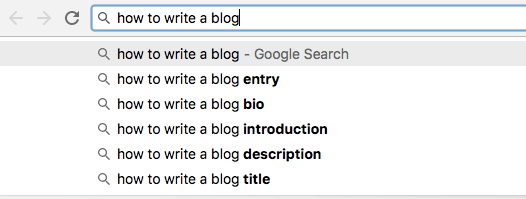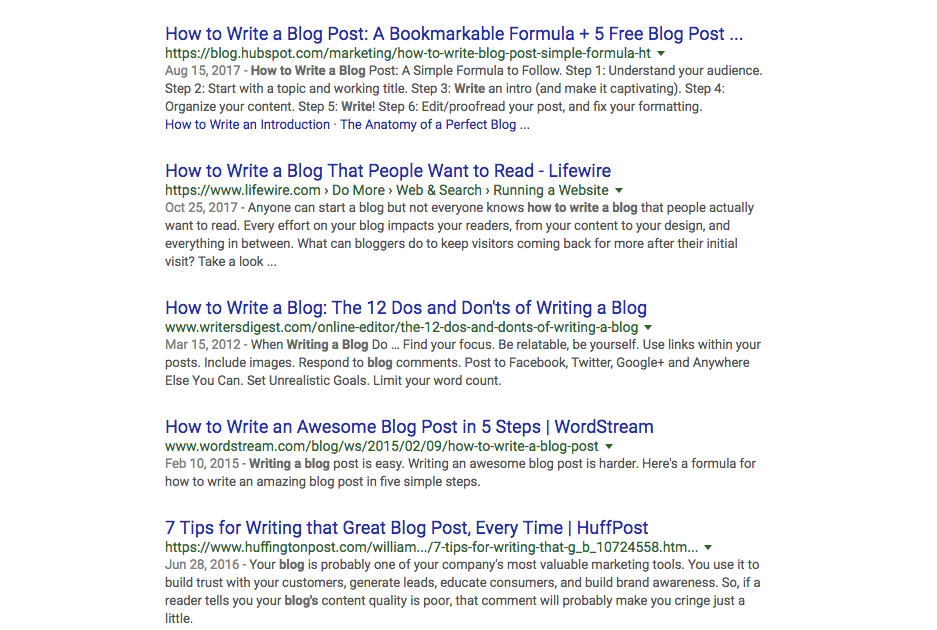How to Select a (Good) Blog Post Topic
December 12th, 2017 by Joshua Loomis

One of the biggest issues I see with company blogs is bad topic selection. Either current, busy employees, or a poor intern, is handed the keys and expected to just knock out articles as much as they can (my first marketing job!).
But this tends to lead to a lot of either overly general or highly sales-y posts. You know the type, “Here’s 7 Ways to Fix a Common Problem, and How About That, They All Involve Our Product, Weird!”
We can do better than that. Here's how.
Step 1: Use the Right Recipe for Audience Intent
Why are the sales-style blog posts bad? Because most your readers aren’t ready to buy. Reading a blog post is towards the top (maybe even the very top) of your sales funnel.
With that in mind, your blog should focus 80% of articles on discussing topics relevant to your audience without directly selling to them. About 15% of articles should discuss issues and topics that might get a reader thinking about buying your product without directly discussing it, and the final 5% should focus on how your product can solve an issue. (This content breakdown comes from Brian Balfour’s Reforge Growth course.)
Let’s use myself as an example, this blog post fits in the 80% of general articles since it’s relevant to an audience wanting to learn more about marketing. The next stage might be an article about how research showing how marketing consulting can be highly beneficial to startups. The final stage could be a case study and testimonial from a current customer.
**This mindset is the essential starting point for making sure you have good blog topics. **
Step 2: Find Your Focus Words
Before you start coming up with topics, you want to make sure you have a chance of ranking, or at least competing, for SEO. You’ll want to find focus keywords to center your content. Make sure you’re giving a range of topics that are all relevant and have SEO potential.
There’s a wide variety of online tools that can help get you started if you’re drawing a complete blank for focus words, but taking the time to think through what your product does, who would use it, and what would be relevant to that audience should help get the creative juices flowing.
Write down anything that comes to mind. Look at your competitors and see what they’re talking about. Don’t be afraid to write your own take on the same topic, but also consider issues they may have overlooked.

After you have a list of search terms, or questions, you’ll want to eliminate ones that are either too competitive or don’t get enough search traffic.
A good trick if you have access to Adwords is to use their estimate cost tool to see how many searches happen for a set of keywords and based on the cost you can figure how competitive that keyword is.
But you can also just do a straight Google Search and see what pops up. How does your site compare with other sites that are on the front page? If it’s a bunch of sites you’ve never heard of before, you have a good chance. If it’s a wiki-how and several large corporate sites, you might want to consider a different topic or carefully phrasing your article to hit something they may have missed.

I won't be doing a post about writing a blog post any time soon.
Step 3: Write Your Headlines
After you’ve brainstormed your focus words, you already have your topics! Congrats! You don’t even need this step!
Except you do. Because with every topic you need excellent headlines and a unique perspective for it to product quality content. Think through how you can make your headline standout.
Can you discuss specific research? Can you pick an argument/go against a common belief? Can you provide useful instruction? Do you have a unique point of view based on your experience?
If you’re struggling to write interesting headlines, force yourself to write 5-10 headlines for every topic or idea that you have. Most of them will be awful, but you’ll force yourself to think past the obvious and find some gems.
After you have a headline, try plugging it into Google. You'll want to guarantee it’s different enough from similar headlines (or to plan to make sure yours is higher quality).
Quick tip: if you want to extra careful use a private or incognito browser to keep the results less skewed.
However, there is one instance where it matters less what the Google results look like for headline: Social. Articles that perform well in SEO are unlikely to also do well on social media and the reverse is true as well (there’s always exceptions). An instructional post might do fantastic for SEO, but receive few clicks on social. A timely post on a current issue may achieve the inverse (this post is aimed more at social).
Either way, after writing and tweaking your headlines, you’ll now have the basis for strong, engaging blog posts. All that’s left to do is to write them! But you’ll be able to write them with the peace of mind that they’re more likely to be successful.
